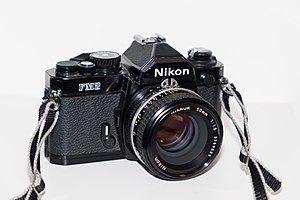 | |
| Overview | |
|---|---|
| Maker | Nikon (Nippon Kogaku K. K.) |
| Type | 35mm SLR |
| Released | 1982 FM2; 1984 FM2n |
| Production | 1982-2001 |
| Lens | |
| Lens mount | Nikon F-mount |
| Focusing | |
| Focus | Manual focus |
| Exposure/metering | |
| Exposure | manual 60/40 center-weighted |
| Flash | |
| Flash | ISO-standard hot shoe |
| Shutter | |
| Frame rate | manually wound |
| General | |
| Dimensions | Approx. 142.5 x 90 x 60mm (5.6 x 3.5 x 2.4 in.), approx. 540g (19 oz.) |
| Made in | Japan |
| Chronology | |
| Successor | Nikon FM3A |
The Nikon FM2 is an advanced semi-professional, interchangeable lens, 35 mm film, single-lens reflex (SLR) camera. It was manufactured by Nippon Kogaku K. K. (today Nikon Corporation) in Japan from 1982 to 2001. The original camera was released with some incremental improvements (such as a higher flash-sync speed) in 1984, and this later version is commonly referred to as the FM2n (for 'new', due to the N preceding the serial number on the rear of the top plate), although both versions are labelled as the FM2 on the front of the camera body.
The FM2 originally used an advanced Nikon-design, metal-bladed, bearing-mounted, vertical-travel purely mechanical focal plane shutter with a (then unheard-of) speed range of 1 to 1/4000th second plus Bulb, plus a fast flash X-sync of 1/250th second. (Actually the first models were with a flash X-sync 1/200th second.) It had dimensions of 90 mm (height), 142 mm (width), 60 mm (depth) and a weight of 540 g. It was available in two colors: black with chrome trim and all black. The introductory US list price for the chrome body only (no lens) was $364. By 1988, it listed for $525; in 1995, it plateaued at $745 and remained there until discontinued. Note that SLRs are usually sold for 30 to 40 percent below list price.
The FM2 is a member of the classic Nikon compact F'x'-series SLRs and was built using the same material—copper-aluminium-silicon (copper-silumin) alloy—as the earlier Nikon FM (introduced in 1977) and FE (1978) cameras. The Nikon FE2 and FA of 1983 also had this silumin alloy construction, along with the limited production Nikon FM3A of 2001, although the design of the housing differs from model to model.